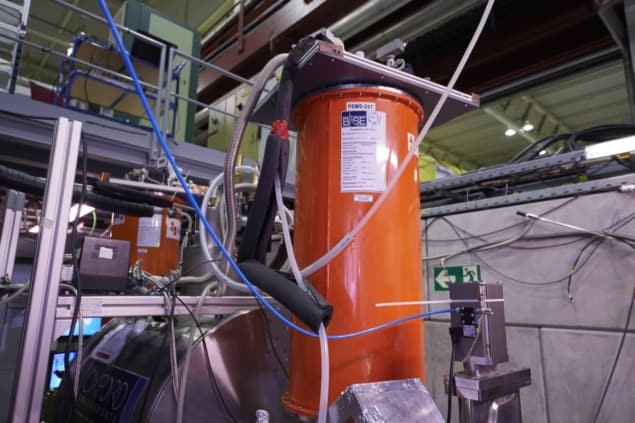Antimatter and matter respond to gravity in the same way, experiment reveals
06 Jan 2022 Hamish Johnston
Precise measurements of the motions of antiprotons and protons suggest that antimatter responds to gravity in the same way as matter. The experiment was done at CERN by the international BASE collaboration and involved trapping antiprotons and negative hydrogen ions using electric and magnetic fields. The measurements also provide the best confirmation yet that the antiproton conforms to certain aspects of the Standard Model of particle physics.
Matter is made of baryons and leptons such as protons and electrons. According to the Standard Model, each of these particles has a corresponding antiparticle with identical mass but opposite charge. Just like protons and electrons, these antiparticles can combine to make antimatter. Indeed, physicists at CERN can make antihydrogen by combining an antiproton with an antielectron. These antiprotons are produced in large numbers at CERN in a facility dubbed the “Antimatter Factory”.
Enduring mystery
An important and enduring mystery in physics is why the universe appears to be made up almost entirely of matter and contains only tiny amounts of antimatter. The answer to this question could be found by looking for tiny differences between a particle and its antiparticle – which if successful would reveal physics beyond the Standard Model.
The BASE experiment at CERN aims to measure the magnetic moment of the antiproton to very high precision so that it can be compared to the magnetic moment of the proton. This is done using a Penning trap, which holds a negatively charged antiproton using magnetic and electric fields.
In this latest research, the BASE team focused instead on the charge-to-mass ratio of the antiproton, which can also be measured to high precision in a Penning trap. The antiproton follows a circular path within the trap and the frequency of this cyclotron oscillation is used to calculate the antiparticle’s charge-to-mass ratio.
The experiment was then repeated using a negatively charged hydrogen ion – which is a proton that is bound to two electrons. This ion was used instead of a positively charged proton so the two measurements could be done under the same experimental conditions – and therefore compared to a very high precision.
Identical results
Measurements were made in four campaigns done between December 2017 and May 2019. In total 24,000 comparisons were made, each lasting 260 s. The BASE physicists found that the charge-to-mass ratios of the antiproton and proton were identical to within 16 parts-per-trillion, which is four times better than previous measurements.
“To reach this precision, we made considerable upgrades to the experiment and carried out the measurements when the antimatter factory was closed down, using our reservoir of antiprotons, which can store antiprotons for years,” explains BASE spokesperson Stefan Ulmer, who is based at RIKEN in Japan.
Their research backs up the principle that the physics of a system is not affected when its charge, parity and direction of time are flipped. This fundamental symmetry is called CPT invariance, which plays an important role in the Standard Model.
“This result represents the most precise direct test of a fundamental symmetry between matter and antimatter, performed with particles made of three quarks, known as baryons, and their antiparticles,” says Ulmer.
Relativistic test
The experiment also tested the weak equivalence principle, which is a consequence of Einstein’s theories of relativity. This principle says that the behaviour of an object in a gravitational field is independent of its intrinsic properties – including its mass. A familiar example is that in a vacuum, a feather and a hammer will freefall with the same acceleration.READ MORE

Earth’s orbit around the Sun is elliptical, which means that the gravity experienced at the Penning trap changes slightly over the course of a year. This change affects the cyclotron frequency and the team found that the frequencies of the proton and antiproton changed in the same way. The team therefore confirmed that the weak equivalence principle applies to both antimatter and matter – to a precision of about three parts in 100.
Other experiments at CERN plan to probe the weak equivalence principle by observing antimatter in freefall and Ulmer points out that BASE’s result is “comparable to the initial precision goals of experiments that aim to drop antihydrogen in the Earth’s gravitational field”. “BASE did not directly drop antimatter in the Earth’s gravitational field, but our measurement of the influence of gravity on a baryonic antimatter particle is conceptually very similar, indicating no anomalous interaction between antimatter and gravity at the achieved level of uncertainty.”
The research is described in Nature.
FROM PHYSICSWORLD.COM 6/1/2022

Δεν υπάρχουν σχόλια:
Δημοσίευση σχολίου